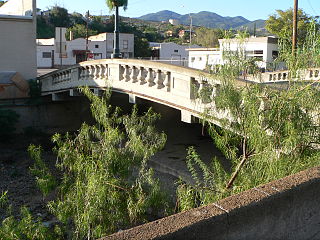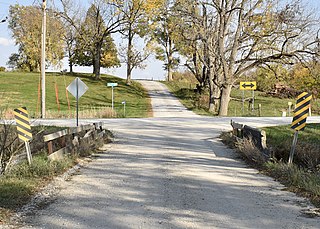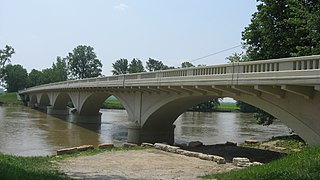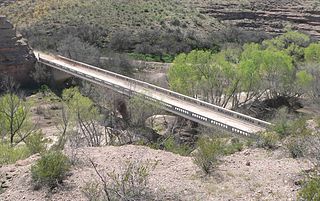
The Dumbarton Bridge, also known as the Q Street Bridge and the Buffalo Bridge, is a historic masonry arch bridge in Washington, D.C.

James Barney Marsh was an American engineer and bridge designer. He patented a new design for arch bridges. Marsh gave Archie Alexander, the first African-American to graduate as an engineer from Iowa State University, his first job. Marsh worked in the bridge building business for over 50 years, and several of his bridges are listed in the National Register of Historic Places.
Luten Bridge Company and variations such as Luten Engineering Company was the name of a number of different bridge building companies in the United States during the early- to mid-20th century. Each had rights to build concrete Luten arch bridges, according to the patented designs of Daniel B. Luten, of Indianapolis.

A Luten arch is a patented concrete arch design for bridges, designed by Daniel B. Luten, of Indianapolis. Luten was awarded more than 30 patents for his improvements of the Luten arch design.

Fossil Creek Bridge is a closed-spandrel deck arch bridge built in the U.S. state of Arizona during 1924–25 on Cottonwood-Camp Verde-Pine road across Fossil Creek. The road, also known as Fossil Creek Road, crosses the creek at a point where it forms the border between Yavapai and Gila counties, and between the Tonto and the Prescott National Forests. The nearest town is Strawberry in Gila County. It is not far from Camp Verde in Yavapai County.

The Missouri Valley Bridge & Iron Co., also known as Missouri Valley Bridge Company, was a engineering, construction, and steel fabrication firm that operated through the late nineteenth and most of the twentieth centuries. It was based in Leavenworth, Kansas, with a WWII facility in Evansville, Indiana.
Topeka Bridge & Iron Co. was a bridge company. Its works include many bridges that are now listed on the U.S. National Register of Historic Places. Its Canyon Diablo Bridge was a concrete Luten arch bridge built in 1914. Its Amelia Park Bridge, for another example, was built in 1914.

The West Second Street–Swartz Creek Bridge in Flint, Michigan, carries West Second Street over Swartz Creek. It was listed on the National Register of Historic Places in 1999.

The Calamus Creek Bridge near Maxwell, Iowa is a concrete Luten arch bridge constructed in 1905. It was built by N. M. Stark and Company for a cost of $900. It has a 25-foot (7.6 m) single span and a total length of 45 feet (14 m).

The Vine Street Bridge in West Union, Iowa brings South Vine St. over Otter Creek. It is a concrete Luten arch bridge built in 1910 by N.M. Stark & Co. It was listed on the National Register of Historic Places in 1998.

The White River Bridge in Elkins, Arkansas is a historic structure carrying County Road 44 over the White River in eastern Washington County. The bridge is a patented closed-spandrel arch design called the Luten arch, owned by the Luten Bridge Company of Knoxville, Tennessee, which emphasized strengthened piers and abutments, resulting in a reduced need for material. This bridge has three arches, with a total length of 192 feet (59 m). After construction in 1921, farmers in southeast Washington County were better able to bring their products to market in Elkins.
Kelvin is an unincorporated community in Pinal County, Arizona, United States. Kelvin is located near the Gila River, 24.6 miles (39.6 km) east-northeast of Florence.

The Evansville-Dutch Mills Road Bridge is a historic bridge in rural western Washington County, Arkansas. It is a single-span concrete filled-spandrel arch bridge, which carries Dutch Mills Road over Whitaker Branch South south of the village of Dutch Mills The bridge was built in 1936 by the Luten Bridge Company, and was one of its last commissions in the county. The arch spans 28 feet (8.5 m) and the bridge has a total structure length of 30 feet (9.1 m). The bridge was built with a unique Luten Company design that used rings to strengthen the connection between the piers and spandrel walls, enabling a reduced amount of material while maintaining the strength of the bridge.

The Illinois River Bridge at Phillips Ford is a historic bridge in rural northern Washington County, Arkansas. It is a double-span closed-spandrel concrete arch bridge built in 1928 by the Luten Bridge Company, and it carries County Road 848 across the Illinois River in the Ozark National Forest south of U.S. Route 412 (US 412). The bridge's arches each span 81 feet (25 m), and the total structure length is 168 feet (51 m). The bridge uses Luten's patented method of reducing material in the bridge by the addition of metal rings to the spandrel walls.

Carrollton Bridge, also known as Carroll County Bridge #132, is a historic closed-spandrel arch bridge that spans the Wabash River in Adams Township, Deer Creek Township, and Tippecanoe Township, Carroll County, Indiana. It was designed by Daniel B. Luten and built in 1927. It consists of six reinforced concrete arches. It has an overall length of 619 feet 4 inches (188.77 m).

The Harp Creek Bridge is a historic bridge in rural northern Newton County, Arkansas, carrying Arkansas Highway 7 across Harp Creek in the hamlet of Harrison. It is an open-spandrel arch bridge, built out of reinforced concrete in 1928 by the Luten Bridge Company. The arches span 69 feet (21 m), and are mounted on piers set 24 feet (7.3 m) from the abutments. The total structure length is 117 feet (36 m), and the deck is 23 feet (7.0 m) wide. Concrete balustrades line the sides of the bridge.

The Twin Bridge is a historic structure located in Twin Bridge Park southwest of Fayette, Iowa, United States. It spans the Little Volga River for 80 feet (24 m). The Fayette County Board of Supervisors contracted with N. M. Stark and Company of Des Moines to build almost all of its bridges between 1900 and 1913. This concrete Luten arch bridge was completed in about 1910 using a patented design by Indianapolis engineer Daniel Luten. Stark was a licensee for Luten and they built multiple bridges using his designs under a patent royalty agreement. The Twin Bridge was listed on the National Register of Historic Places in 1998.

The Beach–Garland Street–Flint River Bridge was a historic Luten arch bridge carrying Beach and Garland streets over the Flint River in Flint, Michigan. It was listed on the National Register of Historic Places in 1999. The bridge served from 1921 until 2006.

The Gila River Bridge near Clifton, Arizona, also known as the Clifton Bridge, is a Luten Arch bridge which was built in 1918. It was listed on the National Register of Historic Places in 1988.
















